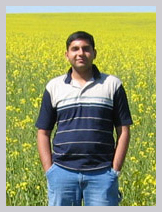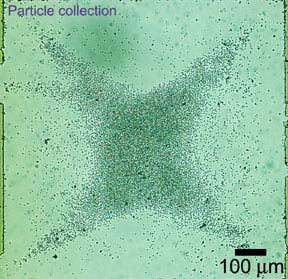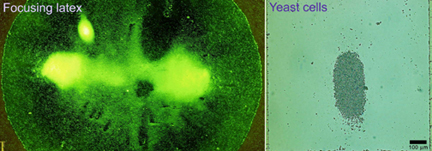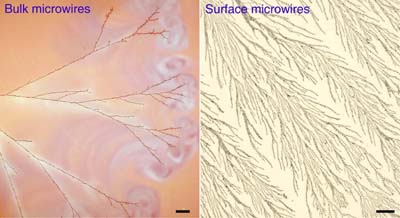Ketan Bhatt
| PhD, Chemical Engineering, 2006 North Carolina State University M.S., Chemical Engineering, 2003 North Carolina State University B.E., Chemical Engineering, 2001 Birla Institute of Technology and Science, Pilani, India |  |
Research Focus: Manipulation, Transport, and Assembly of Colloidal Particles Using Alternating Electric Fields
AC Electrohydrodynamics: Effect arising due to the interaction of ions in the double layer on the surface and the tangential component of the applied electric field. The net result is a liquid motion in the chamber.
Dielectrophoresis: Force exerted on colloidal particles (uncharged dielectric particles and/or conductive particles) by non-uniform electric fields. The particles are either attracted to or repelled from the electric field maxima based on their effective polarizability in the medium.
Particle Collection
Micro-total analysis systems are now being developed for various chemical and biological applications, including biosensors, bio-warfare agent detection and gene separation and analysis. The first step in using any of these systems involves separating and collecting the analytes of interest from the bulk fluid medium. The use of alternating electric fields allows the separation of different particles and further handling and analyzing of the particles of interest. We have developed a new type of AC electrokinetic technique that collects and concentrates colloidal particles from the bulk liquid medium using a combination of AC electrohydrodynamics and dielectrophoresis.
Dilute suspensions (0.001-0.01% solids) of polystyrene microspheres of diameters 0.2-5 µm were collected on patterned electrodes when AC electric fields of 0.5-10 V/mm are applied to the electrodes. The collected particles create patterns with four-fold symmetry inside the “conductive corrals” on the bottom electrode (See figure below).

The collection and concentration of particles in the patterned corrals is a result of the combined action of positive dielectrophoretic force and the AC electrohydrodynamic flow in the chamber. The collection speed and efficiency of the chips is dependent on a number of process parameters, including pattern geometry, particle and electrolyte concentration and field intensity and frequency.
We have used this technique to focus latex particles in a large corral and for collecting yeast cells from buffer solution.

Microwire Assembly
Gold nanoparticles are attracted to the regions of highest electric field intensity when non-uniform fields are applied. The particles coagulate and form 1 µm thick wires. Two modes of microwire assembly have been identified and typical examples of this are shown in figure below. Bulk microwires grow as cylinders through the bulk of the suspension, and surface microwires grow as half cylinders on the glass surface between the electrodes.

By controlling the process parameters we can make straight single connectors, or massively parallel arrays of microwires on the surface of the chip, which can be extracted in dry form (see figure below). The direction of growth of microwires can be guided by introducing conductive islands or particles in the suspension.The experiments, supported by finite element electrostatic calculations, show that the wires grow in the direction of highest field intensity, “automatically” making electrical connections to the objects between the electrodes. The results point the way to controlled dielectrophoretic assembly of nanoparticles into on-chip electrical connectors, switches and networks.

Publications
